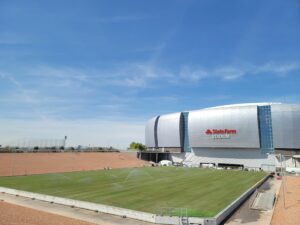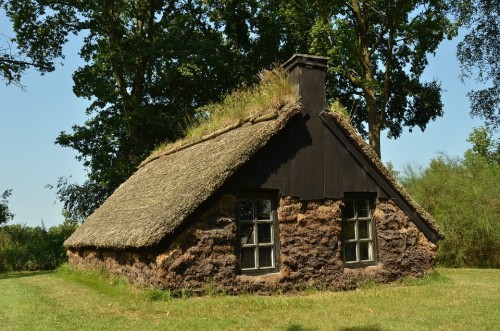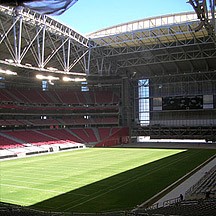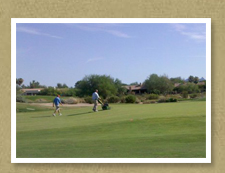An Overview of Palmetto St. Augustine Grass
Thursday, March 16th, 2023Palmetto St. Augustine is the most popular patented turfgrass worldwide. Due to its versatility, this grass is found across most of the southern and southwestern United States and is a popular choice for Arizona homeowners. Homeowners tend to select it over other St. Augustine brands because of its better color, finer texture, and superior tolerance to shade, cold, frost, heat, and drought. This is due to the extensive root system that grows underneath the soil’s surface.
A Look at the Origins of Palmetto St. Augustine
A review of the history of Palmetto St. Augustine reveals that it has a long and varied past. This grass has been used for centuries, from the earliest days of colonial settlements to the modern era. It is a hardy, durable grass that is well-suited for hot, humid, and even dry climates, making it a popular choice for many Arizona homeowners. Its attractive appearance and ability to withstand a range of conditions have made it a favorite among homeowners and gardeners alike.
Originally a specialized grass with enhanced shade tolerance, Palmetto St. Augustine is now found across the globe, with more than two billion square feet sold and demand continuously on the rise.
Information Regarding Palmetto St. Augustine
Palmetto St. Augustine is a type of turfgrass which is native to the southeastern United States. It is an especially popular grass for lawns in Arizona, and it is used for golf courses, parks, and other large areas as well. This grass is quite tolerant of a variety of soil types, temperatures, and moisture levels, making it an ideal choice for many different environments. It is also a low-maintenance grass which requires less fertilization and watering than other types of turf. Additionally, it is resistant to many diseases and pests, which helps it to remain healthy and attractive over time.
Characteristics and Traits of Palmetto St. Augustine Grass
Palmetto St. Augustine grass has distinctive traits and attributes. It is a type of grass that is well-suited for warm climates and is tolerant of humidity. It is a hardy grass that is resistant to drought, heat and salt, which is one of the many reasons it is a popular sod variety in lawns across Phoenix and Tucson, Arizona. The blades are medium to dark green in color and are coarse in texture. It is a low maintenance grass, however, it does require regular fertilization and irrigation. This type of grass is generally free of disease and pests.
In comparison to other varieties of St. Augustine, Palmetto has a more delicate blade that is not as wide. This allows it to make a denser covering of grass. Furthermore, its semi-dwarf stature leads to it growing at a lesser height than other St. Augustines, thus necessitating less cutting to maintain an optimal height.
The natural color of healthy grass is green, but it can have a range of shades and hues. Palmetto is a vivid emerald green.
When it comes to warm-season grasses that can tolerate shade, St. Augustine is at the top of the list, with Palmetto being the cultivar that is the most resilient in this regard.
In comparison to other types of St. Augustines, Palmetto displays a higher resistance to cold, frost, heat and drought.
Establishing Palmetto St. Augustine Grass
For establishing Palmetto in the yard, sod, plugs, or stolons can be utilized; however, there exists no such thing as St. Augustine seed. Installing Palmetto St. Augustine sod is the most suitable option for homeowners looking to have it on their lawn.
If you are thinking about installing Palmetto St. Augustine, then consider contacting the team at Evergreen Turf with any questions you have. If you’re ready to buy, you buy directly on our website.
Upkeep of Palmetto St. Augustine Grass
Mowing and Watering of Palmetto and St. Augustine
Depending on the season, it should be cut to a length of 2-2.5 inches. During the autumn and winter, mowing should be done less frequently and the grass should be left slightly taller than usual. This will help promote the growth of stronger roots during the winter months. You can achieve this by adjusting the mower’s height settings to a slightly higher level.
Weekly, your Palmetto St Augustine sod should receive about an inch of water, including rain. To avoid disease issues, be mindful not to give it too much, as shade and excess moisture can be a breeding ground for disease.
Fertilization of Palmetto St. Augustine grass is an important step in its growth and health. The process of fertilization keeps the grass green and strong, ensuring the lawn looks its best. It is important to fertilize regularly to get the most out of this grass. Check out our lawn care guide: Arizona Sod and Lawn Nutrition & Fertilization for more information.
Controlling insects and diseases in Palmetto St. Augustine is an important task. Using preventative measures to keep the environment healthy is the best way to avoid insects and disease all together. Check out our guide on insect control.
The Saint Augustine grass type is especially vulnerable to chinch bug infestations, so it is wise to use a broad-spectrum insecticide like Bifen L/P if any insect damage is detected. Additionally, white grub worms should be watched for as well. If previous fungal or disease issues have been experienced in the Palmetto grass, a systemic fungicide should be applied in order to avoid future occurrences, particularly during the spring and fall when soil temperatures are changing. Palmetto is able to tolerate more shade than other warm season turfgrasses, making it more susceptible to disease with reduced exposure to sunlight. As such, it is suggested to utilize a fungicide preventively, such as Heritage G Granular Fungicide. Be sure to read product labels before use.
Controlling weeds in Palmetto St. Augustine grass lawns is an important task. Ensuring that weeds don’t overtake the lawn is key to keeping it healthy and looking great.
For St. Augustine turfgrass, it is recommended to use a pre-emergent herbicide in both the spring and fall for effective weed control.






 It’s that time of year again…time for the Arizona Cardinals training camp which includes 18 practices and two preseason home games going on now through August 24. It’s free and open to the public, giving Cardinals fans the opportunity to watch the pro football players practice on the NFL’s top grass field, according to player surveys.
It’s that time of year again…time for the Arizona Cardinals training camp which includes 18 practices and two preseason home games going on now through August 24. It’s free and open to the public, giving Cardinals fans the opportunity to watch the pro football players practice on the NFL’s top grass field, according to player surveys.

